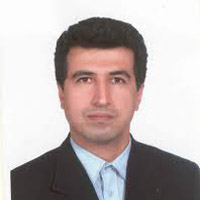The Role of Paleomorpho Dynamic of the Karkheh River in Spatial Structure of the Azadegan Plain
One of the main characteristics of Azadegan plain in the west of Khuzestan province is active instability of geomorphic features of Karkheh River This instability caused extensive variations in the sedimentary setup in the western parts of this plain، such as buried and abandoned river beds، which are repeated over time. Therefore، these variations should be studied in more details in the upper Holocene، since they can help us to better understand the changes and sedimentation details to reduce the environmental hazards in the region. Morpho dynamic characteristics of this river in the flood plains of Khuzestan are influenced by the sedimentation conditions، climatic changes، and hydraulic base levels of the Persian Gulf and in this context the two dynamic river systems of Karoun and Karkheh in Khuzestan are very important to be studied in much detail (Ramesht، 22، 1382). These rivers have been changed the routes in the past in Khuzestan and consequently caused complex sedimentation systems. The morphologic characteristics of these rivers indicate their longitudinal profiles are higher than the main level of the flood plain of Khuzestan. The Karkheh River changed its route in Hamidieyeh position about 100 yrs ago and at the present is running by Sosangard City in Khuzestan. Diopin (2011) studied the routes of the Karkheh، Karoun and Jarhi Rivers in Khuzestan and he found a good correlation among these river dynamics and human developments in this province. He found four different routes for Karkheh River in his study. The objective of this study was to further lighten the route changes and dynamics of the Karkheh River which will help us to better manage the spatial settings and predict the environmental risk in the province. Study Area: Azadegan plain is located in the west of Khuzestan province. This region is about 7500 km2 bordered from north by Shoush and Ilam cities، Iraq from the west، and Ahvaz City the east. Sosangerd is located in the center and the Karkheh River is the major river which drains this extensive plain. The Karkheh rises from the Zagros Mountains and، after pouring into the plain in the northwest، it crosses the Ahwaz anticline near the village of Hamidiya. The river turns into two parallel channels; both ending in the Hawiza Marshes which are located near the Iraq-Iran border. The area has some low hills، named Alaho-ahakbar and Mishdagh، with 173 m above sea level. Active sand dunes are extended from northwest of the province، i. e.، Fakeh and Mousian area. It contains most part of the plain and develops in west of Karkheh، Molla sani، and Maroon Rivers. The average of annual precipitation and temperature are 266 mm and 31 degrees (C°)، respectively. Annual evaporation in lowlands and coastal areas is 2500 mm، which almost more than 10 times of annual precipitation.
In this research the quantitative data، are grouped into two groups of independent and dependent variables. According to the purpose of the study، the river coarse and sedimentary environments are used as independent variables and some other data including particle size، land use، sand dunes extent، and urban areas as dependent variables. The enhancement of abandoned stream channels and scrutiny of active courses of Karkheh River was conducted by using Landsat satellite images of 1990، 1993، 1998، 2002، as well as IRS LISS images of 2006. In this process we used spectral and spatial enhancement indices and recording index points. One of the main indices، which were used for edge enhancement، was gradient filter. The filter was applied in band 7، due to absorption of wavelengths of 2. 08-2. 35 micrometer due to sensitivity to moisture، vegetation، and soil. Given the direction of flows in the rivers in Azadegan، four linear filters of horizontal، vertical، northwest-southeast، and northeast-southwest have were applied for the enhancement process. To better understand the relationship between the condition of sedimentary environments and the sediment types in river dynamics، drilling operation and core sampling were performed. The coring was done by a rotary drilling method up to the depth of 10 meters in Rafi Area in the vicinity of Hoveyzeh Wetland to represent a lake environment and the abandoned channels of the Karkheh fluvial environment in Jafir Region. From these cores، 20 subsamples were selected for granulometric analysis.
Grain size analysis showed interesting results. The grain size in Roafyeh core indicated the percentage of clay fraction (less 0. 002 mm) showed increasing trend with depth، while on the contrary، the sand fraction showed a decreasing trend with depth. Cristian (1997) and Slina (1998) believed stable condition indicates decreased in flow energy with sedimentation of fine grained particles such as silt and clay particles، while unstable condition shows increase in flow energy with lager particle sizes. The results of grain size analysis on the cores in the area showed a both the stable and unstable sedimentation conditions indicating fluctuations in percentage of particles sizes with depth with Three sedimentary sequences in the depths of (0-3، 4-5 and 6-10 meters) could represent humid conditions at the time of sedimentation and. While two periods of dry climate condition were presented with increased sediment particles size in the depths at 3-4 and 5-6 meters،) can be detected in the Rofayeh core. More arid condition along with recession of sea-level could cause Karoun and Karkheh delta to develop with their channel changes during mid Holocene in the area. However، the changes in the Karkheh route from Hamidieh area to Hovaizeh lagoon along with bed deformation and canal displacements occurred naturally and artificially. Due to rapid changes and shear stresses in the river systems، the bends associated with the expansion of sediment transport phenomena، could cause significant damages to agricultural lands and residential areas.
Morphology of the Karkheh River، bed formation، and its translocations in different parts of the Zagross folding belt are dependent upon a variety of factors such as hydraulics، sediment، and tectonic processes. The morphodynamics of Karkheh in proximity of Azadegan Plain is mainly function of folding types and internal factors of tectonic such as uplifting in the area. Moreover، relative sea level changes in the Persian Gulf and sedimentation in of the Karkheh River delta played a main role in its paleo-morphodynamics. Due to global sea level rise in 6000 years ago in the Persian Gulf area (Kent and Kent، 2006)، shoreline of the Persian Gulf was near Ahvaz City up to Hoveyzeh Wetland. Then، with the beginning of shoreline recession from 5500 years ago، in the middle of Holocene، the Karun River delta was developed and experienced movements over the bed of Karkheh River. The shoreline recession was synchronic with cold climatic conditions in high and middle latitudes and with relatively temperate climatic conditions in low latitudes and coastal areas. In such conditions، sedimentary environments were stable with low energy state that allows deposition of fine particles such as clay. Therefore، the changes in climatic conditions altered the situation of sedimentary environments and river morphology in the area. The hazards caused by these changes had significant influences on natural and human spatial features، i. e.، agriculture، civilization، and geomorphologic features. The extended meanders along the margin of the Karkheh River are cut through the sand dunes، caused the translocation of sand sediments onto the point bars along the river path. This process widened the channel beds through generation of developmental meanders which provided suitable lands for agriculture among the sand dunes. The cuttings are stable until the channel beds are not abandoned.
- حق عضویت دریافتی صرف حمایت از نشریات عضو و نگهداری، تکمیل و توسعه مگیران میشود.
- پرداخت حق اشتراک و دانلود مقالات اجازه بازنشر آن در سایر رسانههای چاپی و دیجیتال را به کاربر نمیدهد.




